Spring Break 2003
March 13-24, 2003
March 13
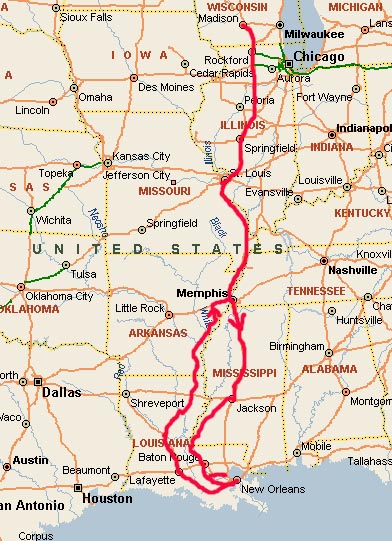 Spring Break has arrived, so it is time to head out of town. The students
escape during Spring Break, so why can't we? Well, now that I have retired (sort
of, only teaching part-time), I can escape during Spring Break. We dug our Roadtrek out of the snow bank, stocked it with food and clothing and headed
south. We managed to get on the road 1 hr and 15 minutes after my class ended,
so I thought that was pretty good! (Nancy: "That is because I had spent the
preceding days loading and preparing.") Our general goal was to visit
Louisiana and New Orleans, figuring that it would be warm and have flowers and
trees in blossom. After the long Wisconsin winter, you miss those things. First
stop was in St. Louis, to spend the night with Dan. Our route is on the map
to the right..
Spring Break has arrived, so it is time to head out of town. The students
escape during Spring Break, so why can't we? Well, now that I have retired (sort
of, only teaching part-time), I can escape during Spring Break. We dug our Roadtrek out of the snow bank, stocked it with food and clothing and headed
south. We managed to get on the road 1 hr and 15 minutes after my class ended,
so I thought that was pretty good! (Nancy: "That is because I had spent the
preceding days loading and preparing.") Our general goal was to visit
Louisiana and New Orleans, figuring that it would be warm and have flowers and
trees in blossom. After the long Wisconsin winter, you miss those things. First
stop was in St. Louis, to spend the night with Dan. Our route is on the map
to the right..
March 14
Headed on farther south. We de-winterized the Roadtrek at a Flying J truck
stop in Memphis (they are RV friendly and have dump stations). In the process I
broke the water strainer on the fresh water tank, so we headed off to find a RV
supply store to get a new one. Headed on farther south into Mississippi, where
we camped for the night. I replaced the water strainer the next morning so we
had a functional water system in the RV.
March 15
After passing through Jackson, MS on I-55, we took the Natchez Trace Parkway
south toward Natchez, MS. The Natchez Trace is an old road built by the army
about 1800. It goes from Natchez, MS to Nashville, TN, a distance of about 440
miles. Pioneers from Tennessee, Ohio, and similar places would float their goods
down river on rafts to New Orleans to sell them. Then they would walk back home.
The Trace went into disuse when the steamboats became common during the 1820s;
riding a steamboat upstream was a lot easier than walking. Currently the Natchez
Trace is operated by the National Park Service and has historical exhibits every
few miles. If you ever get in this part of the country and have the time, it is
well worth it.
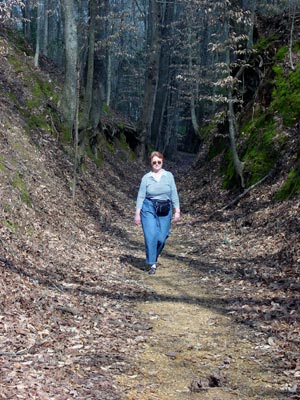
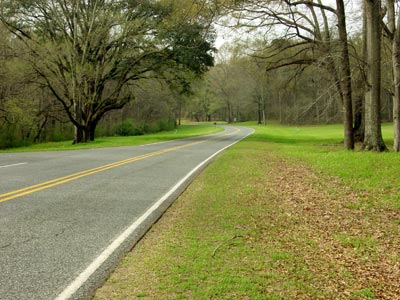
The Natchez Trace now; the speed limit is 50 mph.
The old Natchez Trace, where the foot and horse traffic and
subsequent erosion has caused the road to sink.
March 16
Stopped in St. Francisville, LA to see the old town and the Audubon State
Historic Park. In the park is the Oakley House, which is an old plantation manor
built in 1799. The park is named after Audubon, since he was hired by the family
to tutor their 16 year old daughter. He did many of his famous bird paintings
while in this house. It seems that he was a jerk and got fired by the family
after only four months, but the State of Louisiana named the park after him
anyway.
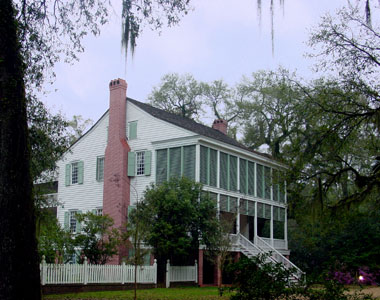
The Oakley House in Audubon State Historic Park, near St.
Francisville.
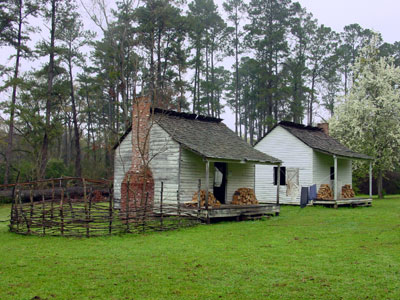
Slave cabins on the Oakley plantation.
March 17-18
Headed on to Baton Rouge to visit the Rural Life Museum. This is a very
interesting museum run by Louisiana State University. It features rural and
pioneer life from the perspective of the ordinary person and slaves. Hence it is
the opposite of the many plantation homes that one can visit; they show life
from the perspective of the plantation owner.
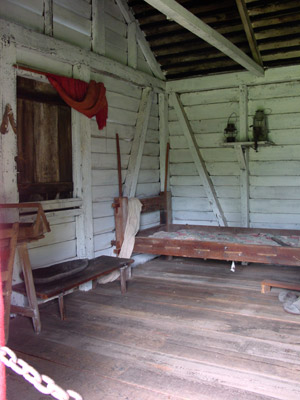
The interior of a slave cabin at the Rural Life Museum. It is
pretty spartan; nothing like the mansion the plantation owners lived in.
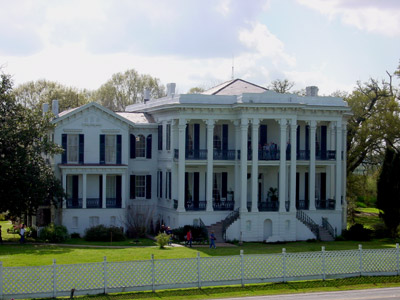
After the Rural Life Museum, we headed along the Mississippi
towards New Orleans. First stop was the Nottoway home, which is a huge
plantation house now run as a bed and breakfast. I was told you can stay
here for about $200/night, but I'm not sure if that is per person or per room.
Like most plantation homes, the ground level is really the basement and used
primarily for storage. The living room, dining room, parlor, library, etc. are
on the second level, and the bedrooms on the third level. The place has 15 foot
ceilings and tall windows to provide relief during the unbearable Louisiana
summers. The kitchen is typically in a separate building to minimize heat in the
house and because of fire danger.

This is the Laura plantation home, which is rather different
than the other plantation homes. This one is Creole; it was built in 1805 by a
French speaking family. After the husband died, the plantation was run by the
women of the family for the next few generations. The African folk tales, which
were later translated into English as the "Br'er Rabbit" stories, were said to
be recorded in the slave cabins on this plantation.
March 18-19
Next stop was New Orleans.
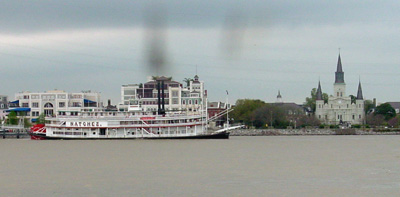 We
took a dinner cruise with a jazz concert on the Natchez sternwheeler on the
Mississippi River. Both the music and food were good.
We
took a dinner cruise with a jazz concert on the Natchez sternwheeler on the
Mississippi River. Both the music and food were good.
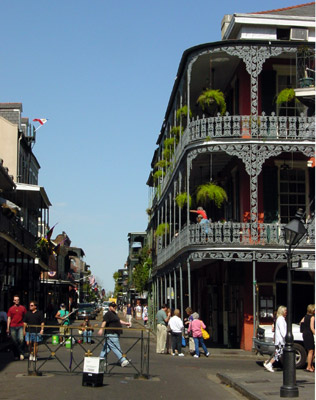
Royal St. in the French Quarter. The street is blocked off during
the middle of the day for street musicians. The ironwork balconies, which are a
trademark of the French Quarter, show the Spanish influence; prior to the
Louisiana purchase, the city was under Spanish rule more than it was under
French rule

Jackson Square, with the statue of Andrew Jackson and the St.
Louis Cathedral. This is the heart of the French Quarter.

People are "buried" above ground in New Orleans and much of
southern Louisiana. This is because the water table is only 3 feet down, causing
caskets to float to the surface. So they don't even try to bury them.
March 20
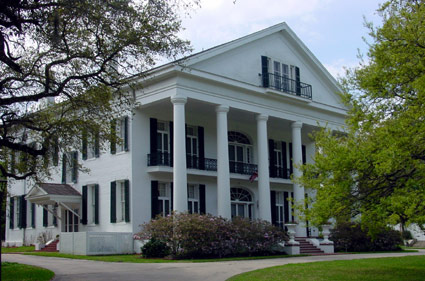 Started
following the old Spanish trail across Southern Louisiana. We stopped at this
plantation manor to take a tour. While driving on the small country lane to this
manor we passed two state police cars and found another sitting in the parking
lot of the manor. That seemed unusual to me. Later we found out the reason; the
manor is the private residence of the current governor of Louisiana. He is quite
an antique collector, including first edition Audubon prints. He didn't come out
to greet us, so I don't know if he was just being impolite or wasn't at home.
Started
following the old Spanish trail across Southern Louisiana. We stopped at this
plantation manor to take a tour. While driving on the small country lane to this
manor we passed two state police cars and found another sitting in the parking
lot of the manor. That seemed unusual to me. Later we found out the reason; the
manor is the private residence of the current governor of Louisiana. He is quite
an antique collector, including first edition Audubon prints. He didn't come out
to greet us, so I don't know if he was just being impolite or wasn't at home.
March 21-22
We happened on to the Poverty Point State Historic Park in northeastern
Louisiana. This is a prehistoric site of Indian earthworks built about 3500
years ago, and is said to be the largest earthworks of that time period in the
western hemisphere. Surrounding the earthworks are a few Indian mounds.
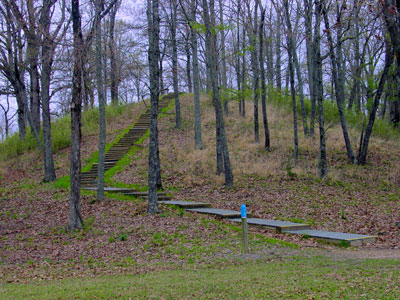
The bird mound at Poverty Point. This mound is about 70 feet
high and 700 feet long. It took a lot of labor to move all that dirt.
March 23
After
Poverty Point we made our way through eastern Arkansas and Missouri to St. Louis
to see Dan again before heading back to Madison. We re-winterized the RV at
Dan's since the weather forecast for the coming week in Madison is rain and snow, with lows down to
15 degrees. Back to winter!
 Spring Break has arrived, so it is time to head out of town. The students
escape during Spring Break, so why can't we? Well, now that I have retired (sort
of, only teaching part-time), I can escape during Spring Break. We dug our Roadtrek out of the snow bank, stocked it with food and clothing and headed
south. We managed to get on the road 1 hr and 15 minutes after my class ended,
so I thought that was pretty good! (Nancy: "That is because I had spent the
preceding days loading and preparing.") Our general goal was to visit
Louisiana and New Orleans, figuring that it would be warm and have flowers and
trees in blossom. After the long Wisconsin winter, you miss those things. First
stop was in St. Louis, to spend the night with Dan. Our route is on the map
to the right..
Spring Break has arrived, so it is time to head out of town. The students
escape during Spring Break, so why can't we? Well, now that I have retired (sort
of, only teaching part-time), I can escape during Spring Break. We dug our Roadtrek out of the snow bank, stocked it with food and clothing and headed
south. We managed to get on the road 1 hr and 15 minutes after my class ended,
so I thought that was pretty good! (Nancy: "That is because I had spent the
preceding days loading and preparing.") Our general goal was to visit
Louisiana and New Orleans, figuring that it would be warm and have flowers and
trees in blossom. After the long Wisconsin winter, you miss those things. First
stop was in St. Louis, to spend the night with Dan. Our route is on the map
to the right..






 We
took a dinner cruise with a jazz concert on the Natchez sternwheeler on the
Mississippi River. Both the music and food were good.
We
took a dinner cruise with a jazz concert on the Natchez sternwheeler on the
Mississippi River. Both the music and food were good.


 Started
following the old Spanish trail across Southern Louisiana. We stopped at this
plantation manor to take a tour. While driving on the small country lane to this
manor we passed two state police cars and found another sitting in the parking
lot of the manor. That seemed unusual to me. Later we found out the reason; the
manor is the private residence of the current governor of Louisiana. He is quite
an antique collector, including first edition Audubon prints. He didn't come out
to greet us, so I don't know if he was just being impolite or wasn't at home.
Started
following the old Spanish trail across Southern Louisiana. We stopped at this
plantation manor to take a tour. While driving on the small country lane to this
manor we passed two state police cars and found another sitting in the parking
lot of the manor. That seemed unusual to me. Later we found out the reason; the
manor is the private residence of the current governor of Louisiana. He is quite
an antique collector, including first edition Audubon prints. He didn't come out
to greet us, so I don't know if he was just being impolite or wasn't at home.